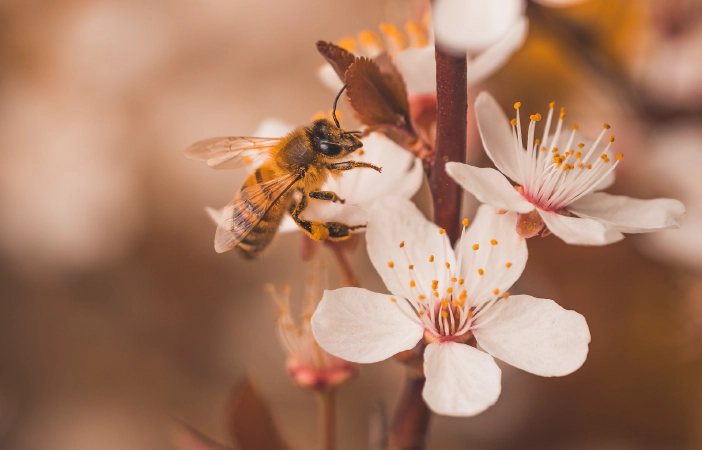
Honey bee vomit! Sounds delicious.
Fortunately, honey isn’t bee vomit. Technically speaking of course.
But before you start gagging at the thought of indulging in bee barf, let me explain the fascinating process that turns this golden liquid into nature’s sweetest treat.
Honey is undoubtedly one of the most beloved and versatile ingredients in the culinary world, so it’s only fair we give credit where credit is due.
So, here’s the lowdown on why honey is basically bee vomit even though it technically isn’t. And — you’ll be surprised to hear — why it’s actually pretty amazing stuff.
Honey Isn’t Technically Vomit
When you hear that honey is bee vomit, you might imagine bees hovering over a pot, spewing out a sticky substance into it. But the reality is a bit more scientific and, dare I say, intriguing.
The process of honey production starts with bees gathering nectar from flowers. This nectar isn’t regurgitated from the bees’ stomachs but is stored in a part of their body called the crop.
The crop is like a handy storage compartment where the bees temporarily hold the nectar before processing it into honey. It’s somewhat similar to how we humans store food in our stomachs before it goes through further digestion.
So, while the nectar does come from the bees, calling honey “vomit” is a bit of an oversimplification.
By storing the nectar in their crops, bees are able to transport it back to the hive where the magical transformation into honey occurs. As the bees regurgitate the nectar from their crops, it mixes with enzymes that break down complex sugars into simpler ones.
This enzymatic process, combined with the evaporation of moisture, results in the thick and delicious substance we know as honey.
So, while honey does come from the bee’s body, it’s not vomit in the traditional sense. It’s more like a precious concoction that bees create through their expertly designed biology.
And trust me, once you take a taste of that sweet, golden goodness, you won’t be thinking about bee vomit anymore. Honey is a culinary delight that adds flavor and sweetness to all kinds of dishes, making it a remarkable gift from the natural world.
The Science: Honey is Regurgitated from the “Crop”, Not the Stomach
Let’s dive into the fascinating science behind honey production and why it’s not actually vomit. When bees collect nectar from flowers, they store it in a part of their body called the crop.
The crop acts as a temporary holding area for the nectar, allowing bees to transport it back to the hive.
But here’s where things get interesting. The actual process of turning nectar into honey happens in the hive, not inside the bees’ bodies.
When a bee returns to the hive, it regurgitates the nectar from its crop and passes it onto other worker bees. These worker bees, in turn, chew on the nectar to break down the complex sugars.
During this chewing process, the bees add enzymes to the nectar. These enzymes help convert the nectar’s sugars into more stable forms, transforming it into honey.
As the bees continue to process the nectar, they also fan their wings to promote evaporation, removing excess water and thickening the texture of the honey.
So, while honey does come from the bee’s body, it’s important to highlight that the transformation into honey occurs outside of their stomachs. It’s a collaborative effort within the hive that takes advantage of the bees’ unique biology and teamwork.
Next time you swirl some honey into your tea or drizzle it over your toast, you can appreciate the intricate process that went into creating this sweet delight. It’s not just some random, haphazard expulsion from a bee’s gut; it’s a beautifully orchestrated symphony of nature’s design.
Honey Does Contain Butyric Acid
Now, let’s talk about a fun fact about honey – it contains a compound called butyric acid. Don’t worry though. It’s naturally present in many foods and is not harmful when consumed in moderation.
But you know what it’s also present in? Human vomit.
And it’s the very thing that gives vomit a “vomity” smell.
But what actually is it?
Well, butyric acid is a short-chain fatty acid that gives honey its unique flavor and aroma. It also contributes to the antimicrobial properties of honey, making it an excellent natural preservative.
In fact, butyric acid is commonly found in other food items like butter, cheese, and even human breast milk (yep, I wanted to gross you out even more here).
Don’t let it scare you away from enjoying honey. Butyric acid is actually responsible for some of the pleasant flavors we associate with certain foods. Really.
You’ll notice it most in chocolate. American chocolate anyway. They don’t seem to like the stuff over in Europe.
It adds a slight tangy and buttery taste to foods, giving it a delightful complexity.
So, the next time you savor a spoonful of honey, appreciate the presence of butyric acid and how it contributes to the overall taste experience. And rest assured, it’s not some dangerous chemical lurking in your sweet jar of goodness.
It’s just a natural compound that adds a little something extra to your favorite golden treat.
Honey is Basically Special Bee Vomit Really
Alright, it’s time to address the elephant in the room. Despite the technicalities and scientific explanations, honey is essentially special bee vomit.
Yes, you heard that right. But before you start questioning your life choices and swear off honey forever, let me explain why it’s not as gross as it sounds.
When bees regurgitate the nectar from their crops and enzymatically transform it into honey, it’s a process that involves some projecting of liquid from their bodies. And technically, that’s a form of vomiting.
But here’s the thing – honey isn’t the result of bees being sick or expelling waste. It’s a unique way for them to process and preserve the nectar they’ve collected.
Think of it this way: bees are like tiny chemists with specialized digestive systems. They take the raw ingredients of nectar, mix in enzymes, reduce moisture through evaporation, and create a wonderfully sweet and stable substance that we know as honey.
It’s an incredible feat of nature’s chemistry lab.
But here’s the even more impressive part. Honey serves a vital purpose for bees.
In the hive, it becomes a crucial source of nutrition, energy, and food storage. Bees rely on honey to sustain themselves during the winter months when food sources are scarce.
So, while we humans enjoy the delicious taste of honey, it’s an essential lifeline for our buzzing friends.
So, yes, honey is essentially bee vomit, but it’s not something to be disgusted by. It’s a marvel of nature’s ingenuity and a testament to the remarkable abilities of bees.
So, the next time you spread honey on your toast or add it to a recipe, take a moment to appreciate the intricate process that went into creating this golden syrup. And maybe give a little nod of thanks to our busy little friends, the honey bees.
